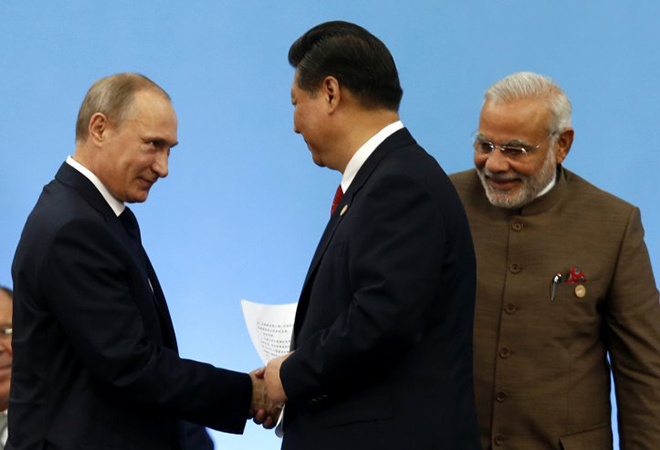Samir Saran| Sushant Sareen
उदारवाद का आकर्षण दक्षिण एशिया में व्यापक रूप से धूमिल पड़ चुका है। राजनीतिक पार्टियां या तो चरम वामपंथ या चरम दक्षिणपंथ की ओर बढ़ चुकी हैं।

वर्तमान सदी के आरंभिक दौर में एक संसदीय समिति ने पड़ोसी देशों के साथ भारत के व्यापार की स्थिति के बारे में अपेक्षाकृत निराशाजनक रिपोर्ट जारी की। इस रिपोर्ट पर सरसरी निगाह डालने से ही क्षेत्रीय व्यापार के प्रश्न पर भारतीय नौकरशाही की संकीर्ण सोच और व्यापारिक बुद्धि वाला पुराना नजरिया स्पष्ट हो जाता है। उदाहरण के लिए, श्रीलंका के साथ मुक्त व्यापार समझौते पर हस्ताक्षर होने के लगभग तीन साल बाद भी इस दिशा में मामूली प्रगति ही हुई। कारण? कृषि क्षेत्र से संबंधित भारत की लॉबियों का कड़ा विरोध,जिन्हें डर था कि श्रीलंका से मिलने वाली जबरदस्त प्रतिस्पर्धा के कारण वे कारोबार से बाहर खदेड़ दिए जाएंगे। क्षेत्र में भारत के सबसे बड़े व्यापारिक साझेदार बांग्लादेश के मामले में भी ऐसा ही हुआ । भारत ने हिल्सा मछली और जमदानी साड़ियों जैसी वस्तुओं के लिए बाजार तक व्यापक पहुंच देने की बांग्लादेश की मांग स्वीकार नहीं की। इन देशों के पाकिस्तान के साथ व्यापारिक वार्ता शुरु करने के बाद ही भारत ने इन संबंधों पर गौर करना शुरु किया।
यहां तक कि अब, जबकि भारत ने अपने संबंधों की शर्तों पर नए सिरे विचार-विमर्श करने का प्रयास कर रहा है, तो भी यह स्पष्ट है कि उभरती भूआर्थिक और भू राजनीतिक वास्तविकताएं क्षेत्र की दिशा बदल रही हैं।
पिछले 70 बरसों के दौरान ज्यादातर समय दक्षिण एशिया का विचार भारत पर आधारित था, जिसे सामंजस्य का वाहक (एजेंट) माना जाता था । भारत का प्रभाव महज धार्मिक, सांस्कृतिक और सभ्यतागत ही नहीं था, बल्कि दक्षिण एशिया के राजनीतिक चिंतन और आर्थिक मॉडलों के केंद्र में भी था।
अब यह आज के दौर में सच नहीं रह गया है। यूं तो दक्षिण एशिया आज भी एक भौगोलिक इकाई की तरह मौजूद है, लेकिन इसके आर्थिक और राजनीतिक महत्व का केंद्र लगातार भारत से दूर खिसकता चला गया है। इसके परिणामस्वरूप, दक्षिण एशिया की पुरानी संरचना अगर मिटी नहीं है, तो मिट रही है। इस प्रक्रिया की शुरुआत के लिए क्षेत्र में भारत की प्रभावहीन शासनकला के अलावा, दो प्रमुख परिपाटियां भी उत्तरदायी हैं।
पहली, उदारवाद का आकर्षण दक्षिण एशिया में व्यापक रूप से धूमिल पड़ चुका है। केंद्र के समाप्त या गायब हो जाने के कारण क्षेत्र की ज्यादातर उदार पार्टियां सिकुड़ कर हाशिए पर जा चुकी हैं। राजनीतिक पार्टियां या तो चरम वामपंथ या चरम दक्षिणपंथ की ओर बढ़ चुकी हैं। क्षेत्र में जहां एक ओर लोकतांत्रिक शासन के चिन्ह अब भी दिखाई देते हैं, वहीं देशों में अनुदारवाद के दौर ने उन्हें उदारवादी लोकतंत्र की विशेषता वाले मूलभूत नियमों से दूर कर दिया है — भले ही पाकिस्तान में जेहादवाद और इस्लामवाद हो, बांग्लादेश में एक दल का वर्चस्व हो, मालदीव में ढीला लोकतंत्र हो (हाल के चुनाव के नतीजों के बावजूद),या नेपाल में कट्टर राष्ट्रवाद हो। ये मूलभूत नियम काफी हद तक, क्षेत्र के लिए नेहरुवादी विज़न के अनुरूप हैं — और भारत लम्बे अर्से तक क्षेत्र की लोकतांत्रिक सामर्थ्य का सहारा रहा है। इस विजन को अब सिर्फ भारत में ही नहीं, बल्कि उसके आस-पड़ोस में भी चुनौती मिलने लगी है।
चीन ‘बेल्ट एंड रोड इनिशिएटिव’ के जरिए एशिया की औपनिवेशिक विरासतों — समुदायों को बांटने वाली एकपक्षीय राजनीतिक सीमाओं को — निरंतर मिटा रहा है। चीन की योजना में, दक्षिण एशिया, ढांचागत परियोजनाओं के जटिल नेटवर्क की महज एक गांठ भर है, जो आखिरकार अखिल यूरेशियाई व्यवस्था का सृजन करेगी। चीन इस उपमहाद्वीप में सुरक्षा, विकास और आर्थिक विकास के अकेले निर्णयाक के तौर पर उभरना चाहता है। चीन नहीं चाहता कि क्षेत्रवाद इस उद्देश्य का ध्यान बंटाए — न ही वह भारत जैसी ताकतों को अपना प्रभाव क्षेत्र कायम करने देना चाहता है। चीन के लिए, ऐसे में किसी तरह की विशिष्ट दक्षिण एशियाई पहचान कोई मायने नहीं रखती । इसकी बजाए वह पाकिस्तान और मालदीव जैसे मुट्ठी भर ग्राहक (क्लाइंट) देशों और बांग्लादेश, नेपाल और श्रीलंका जैसे देशों के साथ आर्थिक संरक्षण की व्यवस्था से उसकी महाद्वीपीय महत्वाकांक्षा की सुरक्षा और आर्थिक हितों की पूर्ति हो सकेगी। वास्तविकता तो यह है कि चीन के मानसिक विश्व मानचित्र में स्वतंत्र दक्षिण एशियाई संरचना के लिए कोई स्थान नहीं है।
लगभग सत्तर बरस के बाद दक्षिण एशिया 1.0 बहुलता की ओर बढ़ रहा है, ऐसे में भारत को हर हाल में दक्षिण एशिया 2.0 की दिशा में प्रयास करने चाहिए, जो आखिरकार बीटा वर्जन का स्थान ले सकेगा, जिस पर वर्तमान में चीन का वर्चस्व है।
चीन की शिकायत या नकल करने से कुछ खास मदद नहीं मिलेगी। लेकिन क्या चीन से प्रतिस्पर्धा करने या उसका मुकाबला करने से कुछ हासिल होगा? आर्थिक, तकनीकी और सैन्य क्षेत्रों में चीन और भारत की ताकत के बीच फासला आज और निकट भविष्य के लिहाज से बहुत ज्यादा है।
ऐसे में सामरिक प्रश्न यह उठता है : भारत इस क्षेत्र में अपना वर्चस्व और प्रभाव कैसे दोबारा हासिल कर सकता है?
सबसे पहले, तो भारत को रणनीतिक संयम प्रदर्शित करना होगा। दूसरे शब्दों में कहें, तो भारत को चीन से सबक सीखने और तेंग शियाओपिंग के कथन ”सही समय आने तक अपनी क्षमताओं को छुपा कर रखो” का अनुसरण करने की जरूरत है।
मौजूदा सत्ता समीकरण को देखते हुए, भारत के लिए अपनी अर्थव्यवस्था का आकार दुगना करने यानी अगले दशक तक मौजूदा 2.6 ट्रिलियन डॉलर से बढ़ा कर 5 ट्रिलियन डॉलर करने तक ज्यादा व्यापक भूमिका निभा पाना नामुमकिन होगा। आवश्यक आर्थिक भार उठाए बगैर अपना प्रभाव आजमाने से सिर्फ पड़ोसियों के साथ रिश्तों में जटिलता ही आएगी। ऐसे में भारत के लिए अच्छा यही रहेगा कि वह फिलहाल कदम पीछे हटा ले। इस समय क्षेत्र के लिए नयी योजनाओं की घोषणा करने की बजाए, भारत को अपनी मौजूदा प्रतिबद्धताओं को पूरा करना चाहिए और तब तक इंतजार करना चाहिए, जब तक भारतीय क्षमताओं में मूलभूत वृद्धि स्वाभाविक तौर पर आस-पड़ोस में उसकी भूमिका और प्रभाव में इजाफा न कर दे।
दूसरा, भारत को दूसरे देशों के मामलों में हस्तक्षेप न करने के नेहरू के सिद्धांत का पालन करना चाहिए। ताकत और प्रभाव के बिना दूसरों को उपदेश देने से पड़ोसियों के साथ सिर्फ नफरत और फासले ही बढ़ेंगे।
भारत को जहां एक ओर अधिकारों पर आधारित एजेंडे के लिए अपनी प्रतिबद्धताओं से समझौता नहीं करना चाहिए, वहीं दूसरी ओर उसे इस एजेंडे को व्यापक रूप देते हुए नैतिकता का एंग्लो—सैक्सन संस्करण (या पाखंड) बनाने की लालसा त्याग देनी चाहिए।
तीसरा, भारत को दक्षिण एशिया भर में चीनी निवेश के लिए सहयोग करना चाहिए, उसे बढ़ावा देना चाहिए और उसका माध्यम बनना चाहिए। यह बात समझने में मुश्किल लग सकती है, लेकिन यदि लक्ष्य-क्षेत्र में भारत के प्रभुत्व को बहाल करना है, तो यह बहुत बड़ा सामरिक बोध है। चीन का अधिकांश निवेश बुनियादी ढांचा और विनियामक व्यवस्था भी तैयार करेगा, जो इन अर्थव्यवस्थाओं के साथ भारत के बाजार को भी जोड़ेगा। अगले दशक में, जब भारत की अर्थव्यवस्था को 5 ट्रिलियन डॉलर के निशान को पार करेगी, तो इस तरह के निवेश भारतीय मुद्रा को क्षेत्र में अपना प्रभाव बहाल करने में मदद करेंगे। ऐसा तभी हो सकेगा, जब चीन के धन के कुछ हिस्सा भारतीय माध्यमों के जरिए प्रसारित किया जाए। उदाहरण के लिए — एशियन इंफ्रास्ट्रक्चर इन्वेस्टमेंट बैंक की तर्ज पर साउथ एशियन डेवलपमेंट बैंक (एसएडीबी)की स्थापना की जाए। केवल इसी मामले में, संस्थागत व्यवस्था से भारतीय नेतृत्व को मदद मिलेगी, जबकि चीन उसका सबसे बड़ा साझेदार होगा। आखिरकार इंडियन ओशन डेवलेपमेंट बैंक की स्थापना के जरिए एसएडीबी के विचार का विस्तार किया जा सकता है, जो हिंद महासागर के तटीय देशों की विकास संबंधी जरूरतें पूरी करेगा।
वक्त आ चुका है कि भारत पीछे हटे और पड़ोसी देशों को चीन के बारे में अपने फैसले खुद लेने दें।
अंत में, भारत को अमेरिका और चीन के साथ अपने संबंधों में संतुलन कायम करने की जरूरत है। दक्षिण एशिया के लिए अपनी जंग जीतने के लिए, चीन और अमेरिका दोनों ही विरोधाभासी तरीके से भारत के लिए महत्वपूर्ण साझेदार है। भारत के दीर्घकालिक आर्थिक विकास के लिए भारतीय बाजारों में चीन का निवेश महत्वपूर्ण बना रहेगा, जबकि अमेरिका की सैन्य क्षमताएं चीन के उदय को संतुलित रखने और मैनेज करने में भारत की मदद करेंगी। एक तरफ, भारत को दक्षिण एशिया में अपने प्रतिनिधित्व को सीमित किए बिना अमेरिका को अपना सुरक्षा साझेदार बनाना होगा। अमेरिका अब ज्यादा महत्वपूर्ण ब्रांड नहीं रह गया है, ऐसे में दक्षिण एशिया से संबंधित भारत की व्यापक रणनीति के दायरे में अमेरिका को लाना प्रतिकूल भी साबित हो सकता है। वहीं दूसरी तरफ, भारत को चीन की क्षेत्रीय योजनाओं को चुपचाप स्वीकार किए बिना उसके धन को स्वीकार करना चाहिए। वास्तव में, यदि भारत को चीन से मुकाबला करना है, तो उसे चीन के ही कंधों पर सवार होना पड़ेगा। यह फैसला बेहतरीन मिसाल बन सकता है: भारत को चीन की महत्वाकांक्षाओं का लाभ उसी तरीके से उठाना चाहिए, जिस तरह चीन के उदय को अमेरिका की अर्थव्यवस्था से सहायता मिली थी। आने वाले दशकों में यही संतुलन कायम करना भारत की प्राथमिकता होनी चाहिए।
वास्तविकता तो यह है कि उपनिवेशवादी लालसा के विरोध के प्रति गहन, गंभीर और भावनात्मक प्रतिबद्धता होने के बावजूद, भारत बेपरवाही से मानता आया है कि भूराजनीति के केंद्र बिंदु आने वाले दशकों में भी यथावत रहेंगे।
दुनिया में कहीं भी ये हकीकत नहीं हैं और काहिरा और बगदाद जैसे शहर अपने अतीत की परछाइयां भर हैं। दक्षिण एशिया 2.0 बनने के लिए भारत को इस क्षेत्र को ब्रिटिश राज के साम्राज्यवादी प्रिज्म से देखना बंद करना होगा। क्षेत्र में भारत की व्यापक नीति के मार्गदर्शक पुराने नारे नहीं, बल्कि नई वास्तविकताएं होनी चाहिए। भारत को आजादी के संक्रमण काल में जो संस्थागत कमजोरियां विरासत में मिली हैं, उन्हें सुधारना होगा, ताकि वह आधुनिक अर्थव्यवस्था की जटिलताओं का 5,000 साल पुराने सभ्यतागत लोकाचारों के साथ मिश्रण कर सके। भारत का दृष्टिकोण उदारवादी लोकतंत्र के प्रति संकल्पबद्धता के साथ त्वरित आर्थिक वृद्धि और क्षेत्रीय अखंडता के निरंतर प्रयासों से मार्गदर्शित होना चाहिए। अपनी प्रगति होने पर, भारत को क्षेत्र की प्रगति पर भी ध्यान देना चाहिए।। कहना आसान है, लेकिन करना मुश्किल है, भले ही क्षेत्र के लिए भारत की ओर से व्यक्त की गई कुछ प्रतिबद्धताएं उसके अपने कारोबारों के लिए कुछ अवधि के लिए देर के लिए मुश्किलों भरी हो सकती हैं। वे उपाय करने के लिए उदार हृदय, साहसपूर्ण दृढ़ता और दूरदर्शितापूर्ण प्रबंधन की जरूरत है, जो केवल नकली पक्षपातरहित राजनीतिक सर्वसम्मति की उपज हो सकती है।
ये लेखक के निजी विचार हैं।


